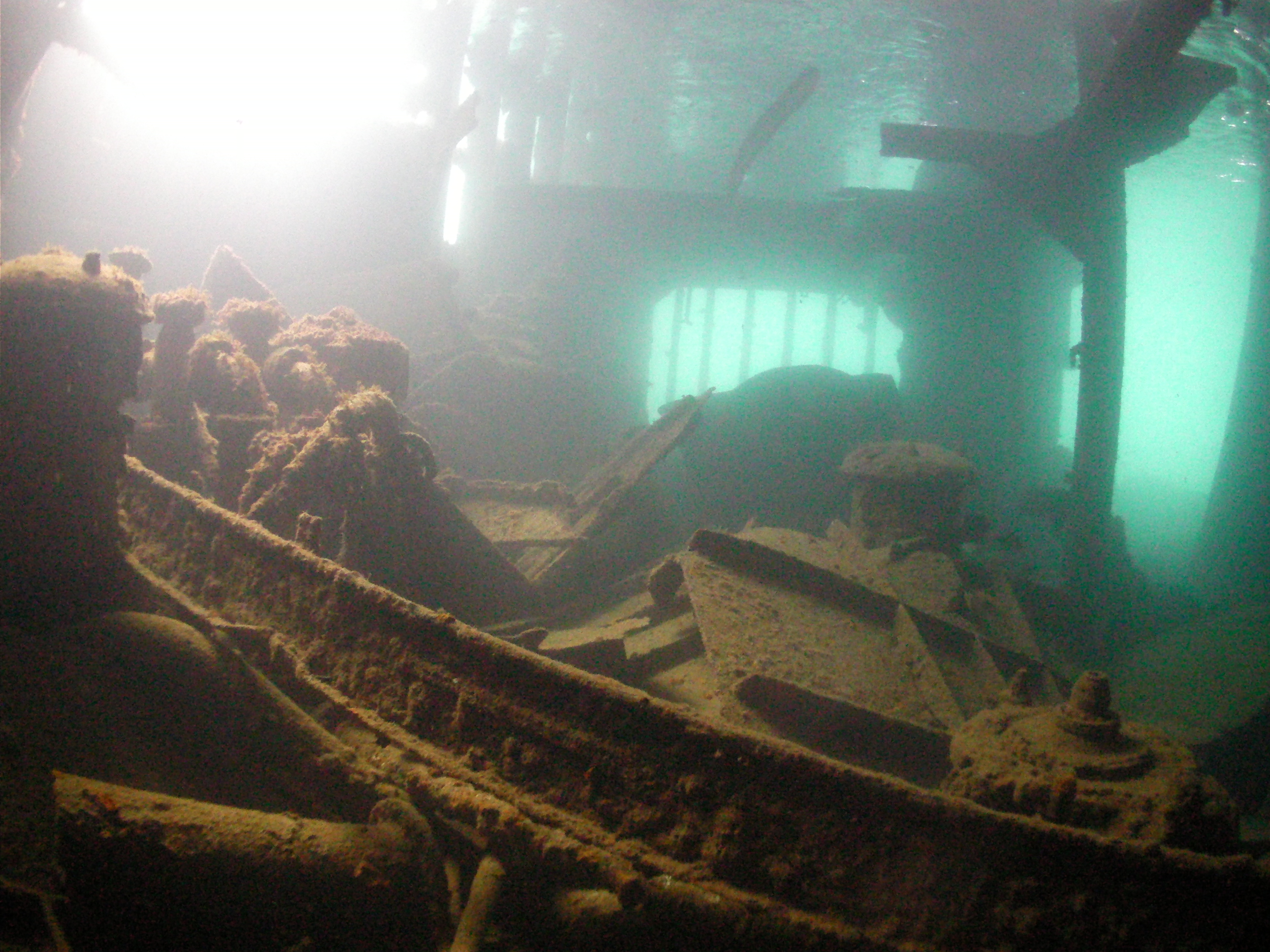News
Reefs, Wrecks and Caves: Lanzarote Dive Trip Report
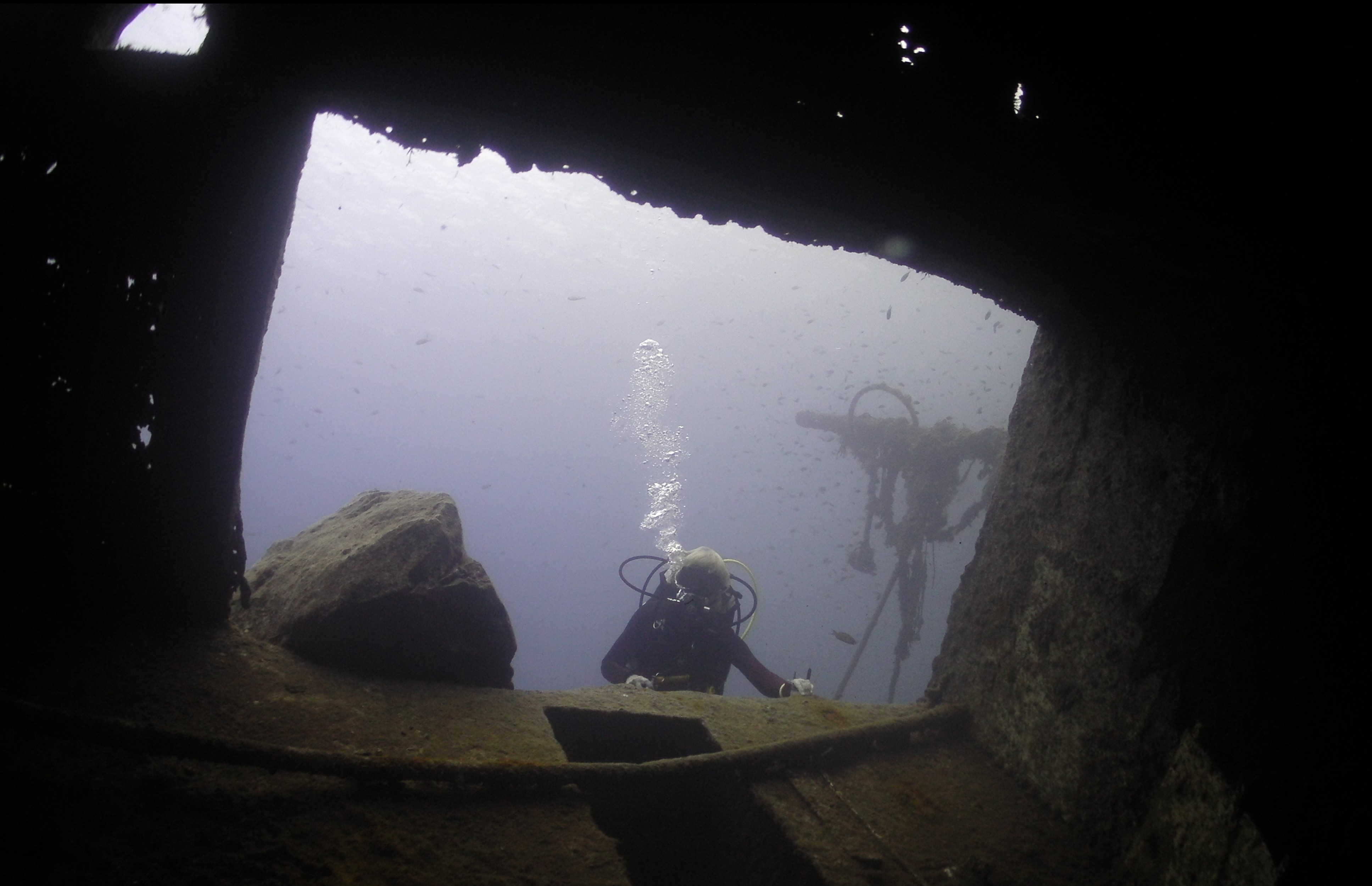
Lanzarote is somewhere visitors either love or hate; probably more for the landscape than anything else, but, along with the other Canary islands, it is coming back into fashion. Over the last three years the resorts have seen increasing numbers of tourists. Is it because of unrest elsewhere in the world, or is there something more? Mark Milburn re-visits the island.
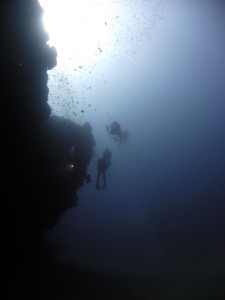 The relatively short flight of under four hours from Bristol was certainly appealing to us. The fastest ever customs check followed. We grabbed our bags and went to pick up the hire car, €45 for a day, roughly the same price as four transfers by coach. Hiring a car meant no waiting, and, no detour around every hotel in the resort. Plus, we had it for the next day. We were staying at Rubimar Aparthotel in Playa Blanca. Playa Blanca is at the south end of the island looking towards Fuertaventura, sheltered from the predominant northerly winds. We had stayed at the hotel before and found it adequate for our needs, which aren’t very great. We checked in and asked about upgrading from self catering to all inclusive, which worked out at €17.81 a day (about £15). That included three meals a day, an afternoon snack and all drinks. Even if we decided to eat out for just one meal a day, it was still cheap. The rooms are starting to look a little tired; but as we found out over our stay, the food had improved massively, so we rarely ate out. We spent the first day acclimatising; we even went to the beach for a snorkel. At the end of the day we went to the dive centre to book in for some diving.
The relatively short flight of under four hours from Bristol was certainly appealing to us. The fastest ever customs check followed. We grabbed our bags and went to pick up the hire car, €45 for a day, roughly the same price as four transfers by coach. Hiring a car meant no waiting, and, no detour around every hotel in the resort. Plus, we had it for the next day. We were staying at Rubimar Aparthotel in Playa Blanca. Playa Blanca is at the south end of the island looking towards Fuertaventura, sheltered from the predominant northerly winds. We had stayed at the hotel before and found it adequate for our needs, which aren’t very great. We checked in and asked about upgrading from self catering to all inclusive, which worked out at €17.81 a day (about £15). That included three meals a day, an afternoon snack and all drinks. Even if we decided to eat out for just one meal a day, it was still cheap. The rooms are starting to look a little tired; but as we found out over our stay, the food had improved massively, so we rarely ate out. We spent the first day acclimatising; we even went to the beach for a snorkel. At the end of the day we went to the dive centre to book in for some diving.
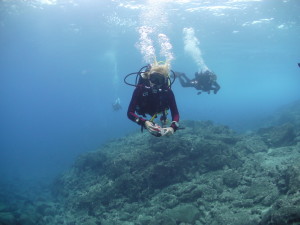 We had to arrive at the dive centre at 08:30, ready to leave on the boat at 09:00. This was fine as the breakfast was ready at 08:00 and the dive centre was only a few minutes walk from our hotel. We loaded our gear onto the boat and were taken to the Twin Pipes site, also known as Emisario. The twin pipes are waste water discharge pipes that head out south on the sand, which at some point had come apart about three hundred metres from the reef. Most dives consist of heading out on the pipes a few metres looking for rays or sharks, then back to the reef. A pleasant enough dive, visibility was around 15m with a water temperature of 24C. Maximum depth was 20m. The morning dives were just an hour apart, but, with free nitrox for suitably qualified divers, it wouldn’t restrict our dive times. The second dive that day was Flamingo Wall, a man-made stone wall protecting a small bathing beach. An easy and relatively shallow dive, teeming with life. For some reason there are schools and schools of fish here, probably more than I have ever seen on any dive anywhere before. A great start.
We had to arrive at the dive centre at 08:30, ready to leave on the boat at 09:00. This was fine as the breakfast was ready at 08:00 and the dive centre was only a few minutes walk from our hotel. We loaded our gear onto the boat and were taken to the Twin Pipes site, also known as Emisario. The twin pipes are waste water discharge pipes that head out south on the sand, which at some point had come apart about three hundred metres from the reef. Most dives consist of heading out on the pipes a few metres looking for rays or sharks, then back to the reef. A pleasant enough dive, visibility was around 15m with a water temperature of 24C. Maximum depth was 20m. The morning dives were just an hour apart, but, with free nitrox for suitably qualified divers, it wouldn’t restrict our dive times. The second dive that day was Flamingo Wall, a man-made stone wall protecting a small bathing beach. An easy and relatively shallow dive, teeming with life. For some reason there are schools and schools of fish here, probably more than I have ever seen on any dive anywhere before. A great start.
The following day we hired mountain bikes and spent the day acquainting ourselves with non-cushioned bike seats on off road trails – comfy. Everyone should try it.
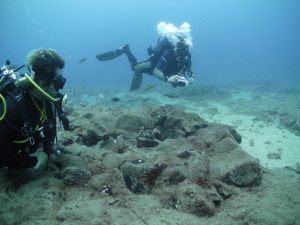 Another dive day. Due to the tidal currents and dive abilities of today’s group, the best sites were Twin Pipes and Flamingo Wall. We decided we would still go. The centre’s owner was happy for us to do our own thing at the sites, as we had dived them before a couple of days beforehand. We wanted to go out to the break in the pipes, as there was loads of life there on our previous visit to Lanzarote. It wasn’t one of the centre’s normal sites though, so they didn’t have any coordinates. We told them to drop us about 150m south of the normal site and we would find our way. We jumped in and looked down as we descended. We could see the seabed from the surface some 20m below us, but we couldn’t see the pipes. There was a slow current running, so we decided it must have moved us across a little. When the pipes eventually came into view, we headed further south. After a ten minute swim, spotting five Angel Sharks and two Eagle Rays on the way, we were at the break in the pipes. Huge schools of barracuda circled the fish below, which were swirling around in a feeding frenzy. It’s an impressive sight; just stay out of the yellowish discharging water. We stayed watching
Another dive day. Due to the tidal currents and dive abilities of today’s group, the best sites were Twin Pipes and Flamingo Wall. We decided we would still go. The centre’s owner was happy for us to do our own thing at the sites, as we had dived them before a couple of days beforehand. We wanted to go out to the break in the pipes, as there was loads of life there on our previous visit to Lanzarote. It wasn’t one of the centre’s normal sites though, so they didn’t have any coordinates. We told them to drop us about 150m south of the normal site and we would find our way. We jumped in and looked down as we descended. We could see the seabed from the surface some 20m below us, but we couldn’t see the pipes. There was a slow current running, so we decided it must have moved us across a little. When the pipes eventually came into view, we headed further south. After a ten minute swim, spotting five Angel Sharks and two Eagle Rays on the way, we were at the break in the pipes. Huge schools of barracuda circled the fish below, which were swirling around in a feeding frenzy. It’s an impressive sight; just stay out of the yellowish discharging water. We stayed watching 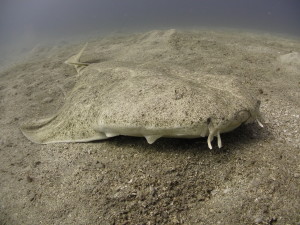 for a while but we knew we had a long swim in front of us if we were going to try and find the anchored boat. We did have a delayed surface marker buoy, should we need it. The return swim was assisted by a small current, which sent us back along the pipes, past the same (or maybe different) Angel Sharks. We reached the reef in just under ten minutes; that current was stronger than we thought. If the boat was anchored in the same place as the previous dive there, we should be able find it, and luckily it was.
for a while but we knew we had a long swim in front of us if we were going to try and find the anchored boat. We did have a delayed surface marker buoy, should we need it. The return swim was assisted by a small current, which sent us back along the pipes, past the same (or maybe different) Angel Sharks. We reached the reef in just under ten minutes; that current was stronger than we thought. If the boat was anchored in the same place as the previous dive there, we should be able find it, and luckily it was.
The next day, for a change, my other half decided to book us on a mountain trek around one of the volcanic peaks. It was quite interesting with some amazing views. It was followed by a long sea swim (I think she is trying to wear me out).
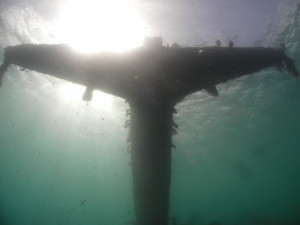 On our third dive day, we arrived at the shop to be met by Sergio. He had been our dive guide on previous visits to Lanzarote and had heard we were back. He no longer worked at the centre as he was chasing a new career, something that could earn money (I can understand that!). He decided he would join us for a dive. He ended up leading the dive around the reef near the lighthouse, il faro de Pechiguera. The area is not known for an abundance of life, but they do get some big fish visit there on occasion. Down we went. Schools of hunting tuna swam overhead, whilst smaller reef fish darted in and out of safety. Barracuda hung mid water, watching. There wasn’t as much life as at the other sites we had visited, especially if you only looked forward and down (you had to look up too). We then came across an area which looked like a field of pink balls; these were balls of Maerl, a calcified seaweed, commonly called Rhodoliths. We also saw a very large scorpion fish, camouflaged in pink. It was nice to dive somewhere different.
On our third dive day, we arrived at the shop to be met by Sergio. He had been our dive guide on previous visits to Lanzarote and had heard we were back. He no longer worked at the centre as he was chasing a new career, something that could earn money (I can understand that!). He decided he would join us for a dive. He ended up leading the dive around the reef near the lighthouse, il faro de Pechiguera. The area is not known for an abundance of life, but they do get some big fish visit there on occasion. Down we went. Schools of hunting tuna swam overhead, whilst smaller reef fish darted in and out of safety. Barracuda hung mid water, watching. There wasn’t as much life as at the other sites we had visited, especially if you only looked forward and down (you had to look up too). We then came across an area which looked like a field of pink balls; these were balls of Maerl, a calcified seaweed, commonly called Rhodoliths. We also saw a very large scorpion fish, camouflaged in pink. It was nice to dive somewhere different.
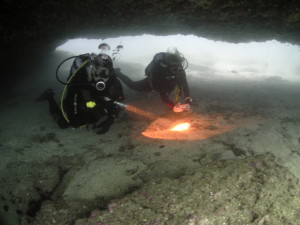 The second dive of the day was going to start at the wreck and cave, then drifting around Punta Berrugo. Sergio was coming for another dive. We were dropped onto the wreck, a very flattened wooden boat, from there we then swam to the cave. The cave is small and not too exciting, but we were escorted by a lot of fish and a small Eagle Ray. We continued with the slow drift eventually finding less and less fish. We then came across a large fishing cage. Like a crab pot but designed to catch anything, its rope had broken and it was full of fish; this was ‘Ghost Fishing’ in the extreme. It wasn’t long before a few of us tried to open the 1.5m diameter wire cage. Between us, we managed to make a couple of holes and by the time we left it, most fish had escaped. The timing wasn’t perfect, as most of us were getting low on air and close to the end of our no stop time; we had done enough though. At least that area will have some more fish for the next group.
The second dive of the day was going to start at the wreck and cave, then drifting around Punta Berrugo. Sergio was coming for another dive. We were dropped onto the wreck, a very flattened wooden boat, from there we then swam to the cave. The cave is small and not too exciting, but we were escorted by a lot of fish and a small Eagle Ray. We continued with the slow drift eventually finding less and less fish. We then came across a large fishing cage. Like a crab pot but designed to catch anything, its rope had broken and it was full of fish; this was ‘Ghost Fishing’ in the extreme. It wasn’t long before a few of us tried to open the 1.5m diameter wire cage. Between us, we managed to make a couple of holes and by the time we left it, most fish had escaped. The timing wasn’t perfect, as most of us were getting low on air and close to the end of our no stop time; we had done enough though. At least that area will have some more fish for the next group.
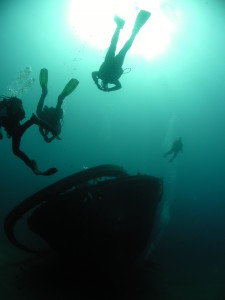 A group of friends had told us about the Temple Hall wreck, the Telamon, a shore dive near Arrecife. We asked the dive centre if we could go there; Sergio said would take us even though he had never dived it himself. Just the two of us met Sergio at the shop at 9:00 and loaded the van. Thirty minutes later we were on a tiny beach, near the remains of the beached ship. The entry was very easy, a gentle stony slope with sandy patches. We did a surface swim to the wreck, which lies stern to shore, and descended next to it, in about 1.5m of water. We headed towards mid ships, where the visible part of the ship ended. The engine room area was open at the break in the ship. We swam around the engine room in a maximum depth of around 3.5m. It was very interesting; it was also dark. Light came through holes around the wreck, creating some interesting light for photographers. From the shore you could just see a piece of wreck sticking out of the water thirty to forty metres in front of the break; we had heard there was more wreckage out there, so swam in that direction. We soon came across the bow, lying on its port side, pointing towards the midships/stern section. The bow itself was quite intact but it was quite broken away behind that. One of the ship’s masts nearly broke the surface from the seabed at around 6m. This section had quite an abundance of life; several schools of fish swam around the wreck’s remains. Almost at the bow there was an opened hatch which went down through three decks, with some great ambient light around the inside. Altogether this was a very nice dive, lots of light because of the maximum depth of 8.4m and a lot of life. I would say a must for photographers that are after well lit wreck shots, with some nice light breaking through.
A group of friends had told us about the Temple Hall wreck, the Telamon, a shore dive near Arrecife. We asked the dive centre if we could go there; Sergio said would take us even though he had never dived it himself. Just the two of us met Sergio at the shop at 9:00 and loaded the van. Thirty minutes later we were on a tiny beach, near the remains of the beached ship. The entry was very easy, a gentle stony slope with sandy patches. We did a surface swim to the wreck, which lies stern to shore, and descended next to it, in about 1.5m of water. We headed towards mid ships, where the visible part of the ship ended. The engine room area was open at the break in the ship. We swam around the engine room in a maximum depth of around 3.5m. It was very interesting; it was also dark. Light came through holes around the wreck, creating some interesting light for photographers. From the shore you could just see a piece of wreck sticking out of the water thirty to forty metres in front of the break; we had heard there was more wreckage out there, so swam in that direction. We soon came across the bow, lying on its port side, pointing towards the midships/stern section. The bow itself was quite intact but it was quite broken away behind that. One of the ship’s masts nearly broke the surface from the seabed at around 6m. This section had quite an abundance of life; several schools of fish swam around the wreck’s remains. Almost at the bow there was an opened hatch which went down through three decks, with some great ambient light around the inside. Altogether this was a very nice dive, lots of light because of the maximum depth of 8.4m and a lot of life. I would say a must for photographers that are after well lit wreck shots, with some nice light breaking through.
Another cycling day, mountain biking around a volcano, then across to the other side of the island. This was nearly the end of me; I had to have some rest, otherwise I wouldn’t make our last diving day.
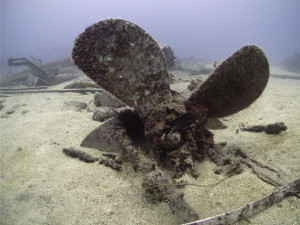 For our last day of diving, we decided we wanted to dive the old harbour wrecks at Puerto del Carmen. These had been deliberately sunk years ago, nice and close so that divers could visit. When someone had decided to extend the harbour, the newly built harbour wall ended up partially covering one of the wrecks. We met at the dive centre at the normal time of 08:30. We put our kit together and loaded the van, which then took us to Puerto del Carmen. The centre operates two dive RIBs, one from Playa Blanca and one from Puerto del Carmen, which made life easy for diving two separate locations. The one minute boat ride went really quickly. We jumped in on the biggest wreck, the one part buried under the harbour wall. Altogether there are about five wrecks there, however some are well broken and don’t look very ship-shape anymore. After visiting all the wrecks, reaching a maximum depth of 37m, we visited a small cave, then returned back to the shallowest wreck. We looked around and checked everyone’s air before going back the the boat, which was now tied to the harbour wall. We went back to the harbour, changed our cylinders and had a little break. Then off to our next site, the orange coral. One of the things about the Canary Islands is there is very little in the way of corals or seaweed, so a whole dive is centred around one piece of coral. It’s not quite that bad, it is just a name for the route you take.
For our last day of diving, we decided we wanted to dive the old harbour wrecks at Puerto del Carmen. These had been deliberately sunk years ago, nice and close so that divers could visit. When someone had decided to extend the harbour, the newly built harbour wall ended up partially covering one of the wrecks. We met at the dive centre at the normal time of 08:30. We put our kit together and loaded the van, which then took us to Puerto del Carmen. The centre operates two dive RIBs, one from Playa Blanca and one from Puerto del Carmen, which made life easy for diving two separate locations. The one minute boat ride went really quickly. We jumped in on the biggest wreck, the one part buried under the harbour wall. Altogether there are about five wrecks there, however some are well broken and don’t look very ship-shape anymore. After visiting all the wrecks, reaching a maximum depth of 37m, we visited a small cave, then returned back to the shallowest wreck. We looked around and checked everyone’s air before going back the the boat, which was now tied to the harbour wall. We went back to the harbour, changed our cylinders and had a little break. Then off to our next site, the orange coral. One of the things about the Canary Islands is there is very little in the way of corals or seaweed, so a whole dive is centred around one piece of coral. It’s not quite that bad, it is just a name for the route you take. 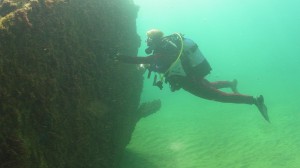 Puerto del Carmen has lots of sites and routes – the orange coral would include a small wreck, the orange coral, a seahorse and a cave. That is exactly what we saw, although we did hope for two seahorses. Another very nice dive, even if it did get a bit busy with divers towards the end. That was our last dive of our holiday. Once our kit was hung out to dry, we returned to our hotel.
Puerto del Carmen has lots of sites and routes – the orange coral would include a small wreck, the orange coral, a seahorse and a cave. That is exactly what we saw, although we did hope for two seahorses. Another very nice dive, even if it did get a bit busy with divers towards the end. That was our last dive of our holiday. Once our kit was hung out to dry, we returned to our hotel.
The last day of our holiday was a rest day, and I needed it. The diving hadn’t been tiring; it was what we did between the diving that tired me out. The weather was almost perfect; we did have a short rain shower on one day and a few night time ones too. The sun had shone and the visibility had, on the whole, been good.
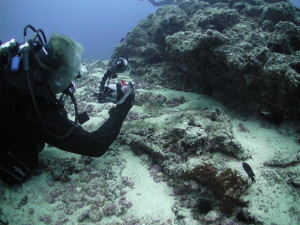 So, had anything changed over the last three years? In reality, no. The diving has always been good; I’d compare it with places like Malta or Mediterranean Spain, but with more life. There is only about three degrees of latitude – less than two hundred miles – between the likes of Egypt and Lanzarote. That makes hardly any difference in temperature during the winter months, with the summer temperatures being a little cooler and more bearable. I spoke to various people around the island, who all seemed to think the increase in tourism was due to perceived troubles elsewhere in the world. That, combined with the great value for money Lanzarote seems to offer, makes the Canary Islands a great option for divers.
So, had anything changed over the last three years? In reality, no. The diving has always been good; I’d compare it with places like Malta or Mediterranean Spain, but with more life. There is only about three degrees of latitude – less than two hundred miles – between the likes of Egypt and Lanzarote. That makes hardly any difference in temperature during the winter months, with the summer temperatures being a little cooler and more bearable. I spoke to various people around the island, who all seemed to think the increase in tourism was due to perceived troubles elsewhere in the world. That, combined with the great value for money Lanzarote seems to offer, makes the Canary Islands a great option for divers.
News
Book Review: Fire on Monroe Bravo by Fred Lockwood

Fire on Monroe Bravo is the latest book in the Jack Collier series by Fred Lockwood. Our story begins with our lead characters, Jack and Sandro, owners of Marine Salvage & Investigation Company, arriving on the Monroe Bravo Oil & Gas Platform in the North Sea. Having secured a contract for their vessel the MV Stavanger to act as support ship to the platform for TransGlobal Oil, our protagonists are on a celebratory visit.
However almost as soon as they arrive a series of explosions rock the platform, causing huge damage, loss of life and the very real danger of a massive human, ecological and financial disaster.

As the danger mounts for both our heroes and the surviving workers, Jack and Sandro will have to escape the inferno, all while trying to save the platform and the men still trapped unable to help themselves.
The disaster sets the scene for the unfolding story lines following the fate of the platform and our main characters, the police investigation into a suspected terrorist act and the actions of TransGlobal Oil as they attempt to navigate the pubic outcry and financial repercussions.
In his eighth book, Fire on Monroe Bravo, Fred Lockwood delivers an explosive thriller, with plenty of above and in-water drama, and our heroes fighting for survival, what more can you ask for?
We thoroughly recommend this read and look forward to the next in the series. For more information about his book series, you can check out the reviews of his previous books here on Scubaverse.
- Title: Fire On Monroe Bravo
- Author: Fred Lockwood
- ISBN: 979-8325324536
Available in a paperback version and for Kindle from Amazon and book stores.
Blogs
Alonissos: The complete diving destination (Part 1)

In June we were incredibly fortunate to be invited to dive in Alonissos, a small Greek Island in the Sporades island chain located in the North Aegean Sea. While I have long been a big fan of the Greek Islands as a great holiday destination, I had not had the opportunity to do any diving on previous visits and Mike and I were extremely excited to see what Alonissos had to offer both above and below the surface!

The Sporades are easily accessible via the airport in Skiathos (the first island in the chain), which is served by Jet2 flights from all major UK airports from May through October. Numerous ferries and charter boats make island hopping from Skiathos Town a breeze. After an hour boat ride, the picturesque port of Patitiri was a wonderful introduction to Alonissos, where we were met by our gracious hosts Kostas of Albedo Travel and Dias of Alonissos Triton Dive Center. Mike and I were delighted to be staying at the Paradise Hotel, aptly named for its stunning views over the sea and great location for walking to the waterfront.

Alonissos is beautifully situated in the National Marine Park of Alonissos and the Northern Sporades, the largest marine protected area in Europe. The surrounding seas offer fabulous marine life, including incredibly rare species such as the Mediterranean monk seal. They boast deep walls covered in gorgonians and sponges, stunning topography with caverns, swimthroughs and pinnacles, and the first accessible ancient shipwreck from 500BC!

In locations where historical sites have been reported, the waters are largely restricted, but with collaboration between government, underwater archeologists and dive centres, incredible underwater museums are being created for a truly unique diving experience. Alonissos is home to the first of these, the Ancient Shipwreck of Peristera Accessible Underwater Archeological Site. The chance to dive into history (along with reports of healthy reef life and amazing underwater topography) meant Mike and I were keen to get in the water.

Our introduction to the diving around Alonissos was at the Agios Georgios Pinnacles, in the channel between Alonissos and Skopelos. This fantastic site was named “The Chimney,’ and proved to have a huge amount to see. We got to a decent depth here (over 25m), and marvelled at a colourful reef wall with a wonderful swim through whose rocky walls were absolutely covered with life. As well as brilliant topography there was no shortage of macro life here. We saw numerous nudibranchs, five different species in total. The second dive at Mourtias reef nearby was a shallower dive along a nice wall with lots of crevices. Several moray eels and grouper called this site home. We enjoyed looking in the crevices for lobster and smaller benthic life, such as cup corals and tunicates.

Our itinerary allowed us two dives a day with afternoons left to explore the island with our hire car and evenings to enjoy the famous Greek hospitality. This proved to be a lovely mix of in-water and land based diversions.

The next days diving to the Gorgonian Gardens and Triton’s Cave was to be even better! These two stunning sites are nothing short of fabulous. The Gorgonian Gardens was a deep wall near to the Agios Georgios islands. The ever-present currents in this deep channel meant that the sea life was amazing … the namesake Gorgonian sea fans dotted the wall at a depth of 30 to 50 meters, getting ever larger the deeper we went. Above 30m was by no means less beautiful, with sponges, corals, scorpionfish, moray eels and some rare and colourful nudibranchs.

The second shallower dive of the day was to Triton’s Cave or the Cavern of Skopelos, on the east side of that island. The spectacular rock formations had wild striations both above and below the water making a truly epic topography. The cavern entrance was at 14m, and big enough for a buddy pair, winding up to 6m and passing two beautiful windows out into the blue. Emerging from the cavern, the light at the shallower depths and the incredible rock formations made for a fantastic gentle swimming safety stop and we all surfaced by the boat with massive grins.

Check out our next blog :Alonissos: The complete diving destination (Part 2)” to hear about our amazing dive on the 2500 year old Peristera Wreck!
Thanks to:
Alonissos Triton Dive Center https://bestdivingingreece.com/
Albedo Travel https://alonissosholidays.com/activities/
Paradise Hotel https://paradise-hotel.gr/
Alonissos Municipality https://alonissos.gr/en/
-

 Blogs2 months ago
Blogs2 months agoDiving With… Nico, Ocean Earth Travels, Indonesia
-

 News1 month ago
News1 month agoMurex Bangka Announce New Oceanfront Cottages & Beachfront Dining
-

 Blogs2 months ago
Blogs2 months agoA new idea in freediving from RAID
-

 Marine Life & Conservation1 month ago
Marine Life & Conservation1 month agoIceland issue millionaire whale hunter a licence to murder 128 vulnerable fin whales
-

 Marine Life & Conservation2 months ago
Marine Life & Conservation2 months agoThe Shark Trust Great Shark Snapshot is back
-

 News3 months ago
News3 months agoCharting New Waters; NovoScuba Goes Global with the Launch of their Revolutionary Dive Training Agency!
-

 Gear News1 month ago
Gear News1 month agoNew Suunto Ocean – a dive computer and GPS sports watch in one for adventures below and above the surface
-

 Marine Life & Conservation Blogs2 months ago
Marine Life & Conservation Blogs2 months agoBook Review: Plankton


